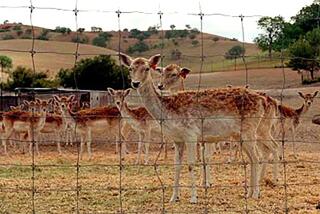Rescued horse is retrained to be a ‘bombproof’ pack animal
HUNTINGTON LAKE, Calif. — Comanche has one pale blue eye, one deep brown and a prancing gait that has cowboy Morgan Austin suspecting this mystery horse once paraded around an arena.
Until two weeks ago, Comanche wouldn’t let anyone in the saddle. It took Morgan, 17, two months of talking to him “real quiet-like,” slipping on a saddle blanket, then the saddle, before he could hoist his own lanky frame onto the brown-and-white quarter horse.
Now, on a day when the sky is pale with heat and ragged breaths of wind kick up thick, sticky dust, Comanche and Morgan lead the way down a boulder-strewn Sierra trail. Clifford Housley, the pack station foreman and head trainer, rides behind, blocking the way should Comanche try to bolt back. Morgan reaches out to snap pine branches with a loud crack and slaps his stirrups against granite, part of training Comanche to be a High Sierra packhorse.
“He has to be dead broke,” Morgan said. “That means bombproof — you could ride that horse through a thunderstorm without him blinking.”
Usually, a horse expected to carry tourists through the wilderness would be raised in the mountains. But these are brutal times in the horse world. Comanche, a flatlander, is being groomed for this job as a way to save his life.
The number of abandoned horses has more than doubled nationwide in the last five years, according to rescue groups. But in the Central Valley, where banks foreclosed on homes and ranches at one of the highest rates in the country, the numbers are even harsher. The Central California Society for the Prevention of Cruelty to Animals went from rescuing a few horses a year to taking in 60 abandoned horses over the last 12 months. Drought and incentives to convert crops to ethanol helped double the price of hay to as much as $20 a bale. It reached a point where even a purebred horse sold for less than the cost of feeding it for a year.
People who had collected the animals as prized trophies left herds to starve.
Comanche was one of 15 horses abandoned on a Sanger, Calif., ranch by a man who had won a $40-million Super Lotto jackpot in 2001. It was one of a string of high-profile mass horse-abuse cases in the Central Valley last winter.
“Horses are a luxury item, and the economic crisis turned the horse world upside-down,” said Beth DeCaprio, who runs Grace Foundation horse rescue outside Sacramento.
On the trail, Comanche, who was dangerously thin when he was rescued, has come to a creek. He pulls back his head, sends rocks clattering with his hooves. Morgan, who also rides broncos and ropes steers, is calmly fighting for control.
Housley brings his horse behind Comanche and herds him across the water. Then they turn him back to recross the tiny creek. The return trip is worse. Comanche rears, pawing the air.
This is one of those moments when things can quickly go wrong and someone gets hurt. Housley and Morgan can list the parts of their bodies that they’ve broken, pulled and twisted.
But once the strange, hissing water is left behind, Comanche settles down.
“That horse is wound tighter than an eight-day clock,” Housley tells Morgan.
“But you’re going to be OK, right, boy?” Morgan says, patting Comanche’s neck. “You’ve just never crossed creeks before.”
****
At D&F; Pack Station, owner Sue Walker is trying to pet two young colts adopted at the same time as Comanche. They were rescued from a group of 18 horses found starving and nearly wild at a ranch in Clovis in the valley below. They were probably foaled in the field.
They push their muzzles close to Walker but shy away when she reaches to touch them. For some reason, however, they let children pet them. She always sends the kids who are going on trail rides over to their corral.
To hear of horses being abandoned was once rare, she said with a shake of her head.
“Every once in a while you’d hear about a horse being abused and you’d just want to shoot the person, but it was one or two horses and life went on,” she said. “But then it was 30, 60, 100 horses left to starve. And I thought, there’s something we can do about it, at least for a few of them, so let’s go do it.”
Walker and her husband, Randy, told Housley to grab a saddle and drive with them to Fresno. They were going to adopt as many horses as they could find jobs for at the station. The SPCA was holding more than 30 horses.
Randy Walker knew Housley, 22, was the right man to do the choosing.
“Clifford can spend 20 minutes with a horse and before even riding it tell you everything about it,” he said. “It’s the craziest thing. I’ve seen him just put his head on their head like they’re communing.”
Housley wasn’t crazy about the responsibility.
“I’m not going to lie to you,” he said in a velvet drawl that may have something to do with his spell over horses. “I was nervous putting a halter on them and trying to guess whether they’d ever been ridden before I got on.
“Also, it’s like going to the pound. You save the one dog, but you have to see all the ones you leave behind.”
Many of the horses had suffered too much muscle damage to be suitable for trail work. Comanche was stronger because he’d been the friendliest, and neighbors couldn’t resist giving him apples.
“You know that part bothered me more than all the rest,” Sue Walker said. “The thought that someone could pet and feed one horse and watch the others dying.”
Housley gave the nod to the two younger ones because they seemed to desperately want contact, although fear held them back. He said he also liked a skittish bay thoroughbred from the wild group, but he couldn’t explain why.
“She’s going to be a lot of work. She won’t ever be a horse you can just stick anybody on,” he told Randy Walker.
“But you like her?” Walker asked.
“She’s going to be a lot of work,” Housley repeated.
“The way I see it, Cliff, in cases like this, there’s everything to gain and nothing to lose,” Walker said and then told his wife to add the price of the filly to the check she was writing.
They named the horse Riata. So far, they can barely get a halter on her. Housley still likes her best.
****
There’s a late-afternoon lull. The last trail ride has left in a lazy, hanging cloud of dust. Riata, tied to a hitching post, has finally stopped her piercing whine.
A 6-year-old girl back from her first ride comes up to show Randy Walker that she is still holding the horseshoe he gave her the way he taught her: sides up, like a smiling face.
“That’s right, he tells her. “If you turn a horse shoe upside-down, the luck runs out the bottom. You have to keep it upright.”
Morgan is by the tack shed, practicing his rope tricks. He forms a big wagon wheel shape with the rope and then jumps through it.
He’ll go back to high school classes, dressed the same as now: cowboy boots, hat and saucer-sizedMother’s Dayrodeo belt buckle. Both sides of his family have been running cattle in the Fresno area for generations. Polite and sunny, Morgan has the personality of a teenager born into a life that he’s never doubted suits him.
He is positive that Comanche can become a horse entrusted to carry even children or grandparents or the terminally ill campers who come once a year to ride. He thinks Comanche will be ready by the end of this summer, certainly by the next.
Housley, five years older, is reserving judgment.
He senses a sweetness and patience in Comanche — perfect traits for a trail horse. But the horse bears personality scars.
“You can see he was broke real rough. It’s a different style of training, and we don’t do it around here because, well, it’s just not nice,” Housley said. “But, now, Comanche thinks that anything he does has to be great. Ask him to move over a couple of inches and he jumps 2 feet. He’s flashy.”
Housley, who is trying to transform from a seasonal, good-time cowboy to year-round employee, knows how hard it can be to dump the flash for steady dependability.
On a recent night after too much to drink, he rode his horse, Jesse James, into the local saloon, stood on its back, removed a sombrero kept on the wall, and rode out wearing the sparkly embroidered hat.
But in the two years since the Walkers bought the packing station and put their faith in him, he’s found his place. He believes Comanche and Riata will too.
If not, they will still have a year-round home at the Walkers’ winter ranch, below in the foothills.
But if Riata learns to trust Housley, she’ll be his personal trail horse. If Comanche proves himself, he’ll be entrusted with carrying strangers into the wilderness. Every summer, on trips somewhere in the High Sierra, he’ll be a dead-broke, bombproof testament to second chances.
More to Read
Sign up for Essential California
The most important California stories and recommendations in your inbox every morning.
You may occasionally receive promotional content from the Los Angeles Times.











